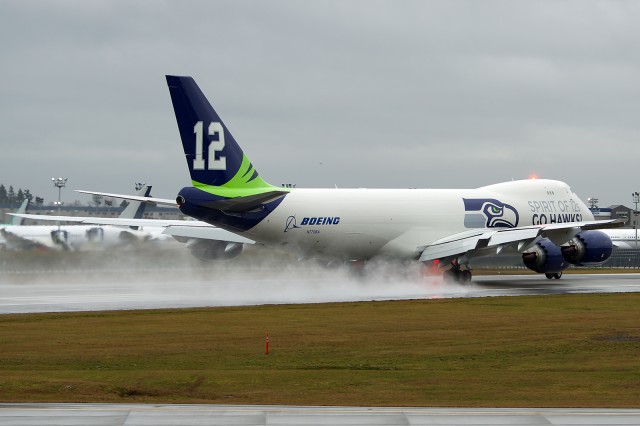
The Spirit of 12s Boeing 747-8 Freighter taking off at Paine Field – Photo: Bernie Leighton | AirlineReporter
The Spirit of the 12s Boeing 747-8F has been pretty popular, especially by tracing a 12 using their flight path. Tomorrow, Saturday the 1st from 11am to 1pm, it will be on the ground next to the The Future of Flight Aviation Center & Boeing Tour where you take photos and cheer on the Seahawks.
There will be a special Seahawks rally that starts at noon (arriving by 11:30am is suggested) and then fans will be able to file past the specially-painted 747-8F and take photos. Admission to the rally and taking photos are free. If you like the Seahawks and you like airplanes, this might be your thing.
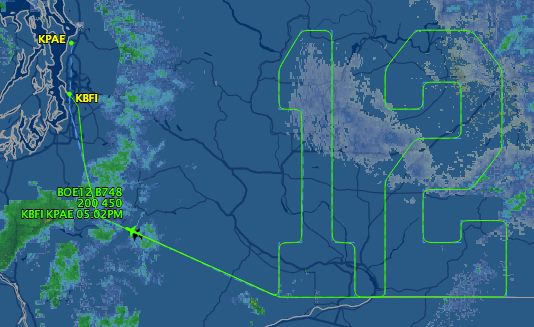
A special flight path for a special plane – Image: FlightAware.com
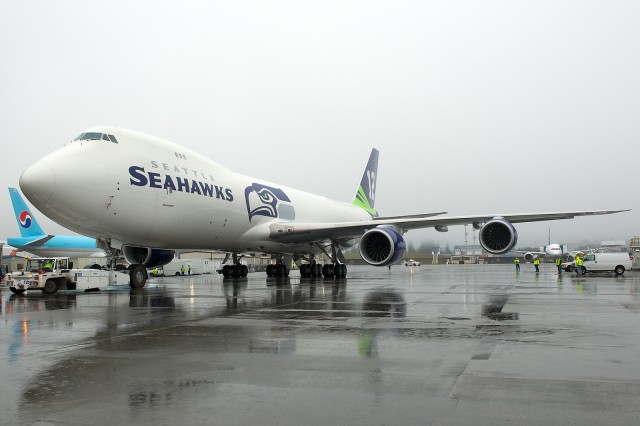
The left-hand side of the freshly-unveiled Seattle Seahawks Boeing 747-8F – Photo: Bernie Leighton | AirlineReporter.com
To those of us in the Seattle area, it comes as no surprise that everyone has been pretty excited that the Seahawks are going to the Super Bowl.
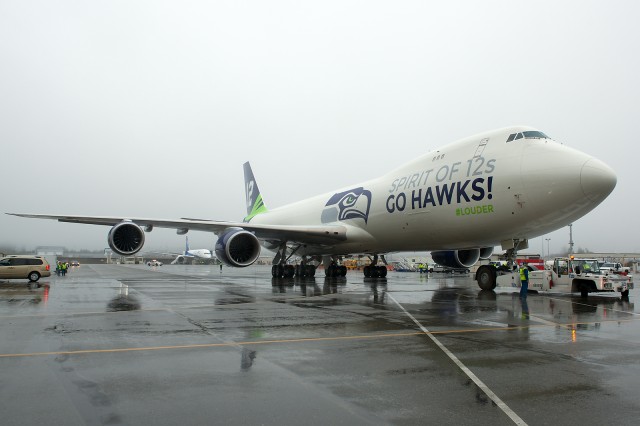
The right side of the Boeing Seahawks aircraft – Photo: Bernie Leighton | AirlineReporter
Boeing, being one of the largest corporate sponsors of the Seahawks, has decided to join in. How they showed their support is exceptional.
It started with a surprise email from the Boeing media department this morning asking if we could attend an event at 2:00pm today. We could, and it ended with the reveal. We would have been on the ramp longer, but unfortunately, it was not only pouring rain but also deceptively cold.
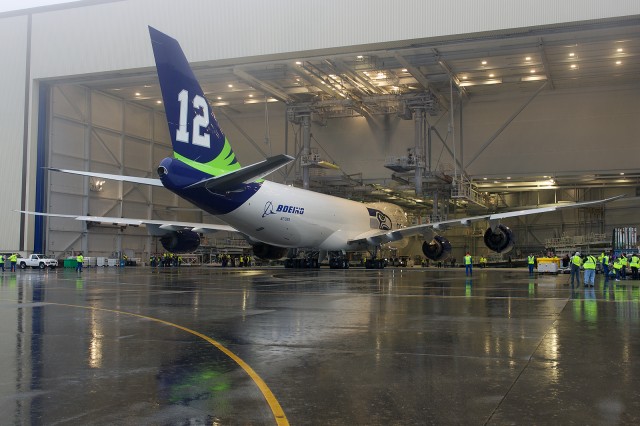
The Seahawks aircraft grand reveal from Building 45-01 – Photo: Bernie Leighton | AirlineReporter
Since I haven’t much to say – other than that I am in awe of the amazing effort undertaken and speed with which Boeing was able to get this top secret project completed – allow me to share some Seahawks-related 747-8 facts straight from Boeing.
The loudest Seahawks game is 38 times louder than the 747-8 is on departure. I know it may not seem that way numerically, but sound pressure is a logarithmic measurement.
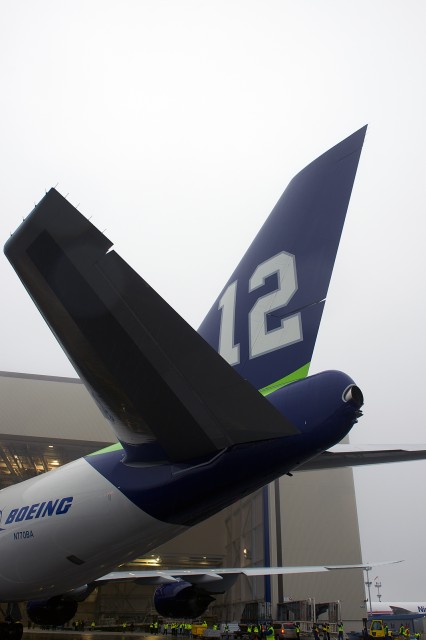
Nothing like having a special scheme elevator hanging over your head Photo: Bernie Leighton | AirlineReporter
Also, I am told that a 747-8F can carry roughly 121 million individual Skittles candies (if that makes no sense, it’s explained here). This is a sight I would love to partake in at some point.
For reference, N770BA used to look like this:
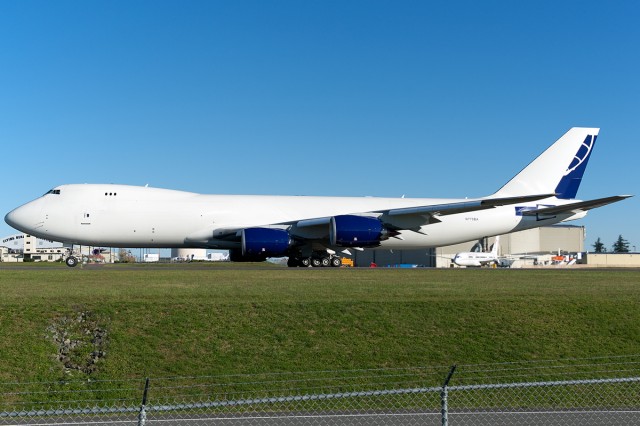
N770BA prior to its new role – Photo: Bernie Leighton | AirlineReporter
If you were wondering, this aircraft will be flying around the Seattle Area as a part of its test program. This aircraft, despite its stunning new livery, is still part of the Boeing test fleet. Of all the aircraft to paint, this one makes the most sense. No angry customers, and the opportunity to play with a blank canvas. It may just so happen that while the aircraft is painted like this, and prior to the Super Bowl- that this test routine will have some deviations from the norms. For example, do not be surprised if one of the tests Boeing performs over the next few days is “How does it look near the Space Needle?”.
If you haven’t caught the new WestJet #MagicPlane livery, you are in for a real treat. It is a complicated design that was not an easy task to complete. This time-lapse video above demonstrates the painstaking steps it took to bring this design to life.
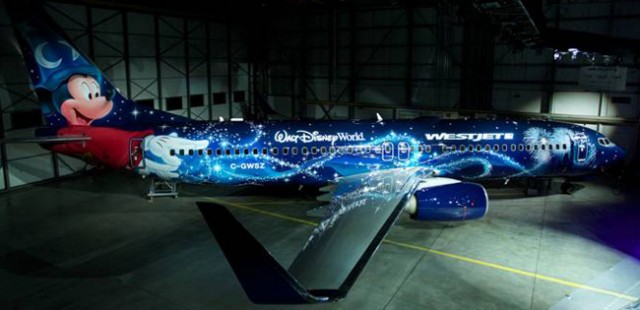
The completed #MagicPlane livery (reg: C-GWSZ). Photo: WestJet
According to WestJet, “The special livery is designed to tell a story from tail to nose. It starts with Sorcerer Mickey, prominent on the aircraft’s tail, with magic stars coming from his hands. The magic stars swirl around the fuselage and past the wings, culminating with fireworks over the Cinderella Castle at Walt Disney World.”
BONUS: Alaska Airlines Unveils its Latest Disneyland Scheme
It took a total of 26 workers, using 36 different colo(u)rs, 24 days working around the clock to make the paint scheme work. Now that is dedication, but we think it paid off. Check out some more photos, plus some magic in the interior:
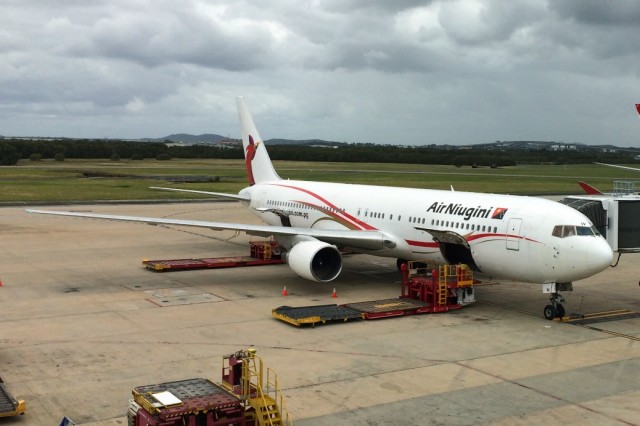
P2-PXV, a 767-383ER waiting for boarding at BNE – Photo: Bernie Leighton | AirlineReporter
So, you’re dumb enough to decide you want to go to Port Moresby on holiday? Well, first off, you are pretty dumb. Do you know how dangerous Port Moresby is? The American government clearly knows; they’re building a new fortress-embassy on the highway to the airport. This embassy construction site also houses all its workers behind three 20-foot high fences and a small contingent of Marines. Having said that, it is still safer than Lae! So, if you have to pick between the two…
It’s not an organized sort of crime, or resistance. It’s something more like a zombie movie. One target sees an opportunity and then, almost like a wave, the rest follows. From what I’ve seen, cricket bats are a popular weapon of late.
I suppose muggings and general mischief do take the edge off after the national pastime, chewing buai, was banned this year. Not that the other three activities were not popular before- they’re just all rather hard to do with a buai, and some mustard, turning your teeth and saliva bright red!
It is the most bizarre dichotomy, because at the same time, I have never met any people more welcoming, helpful, and friendly as the general Melanesians in the very same place.
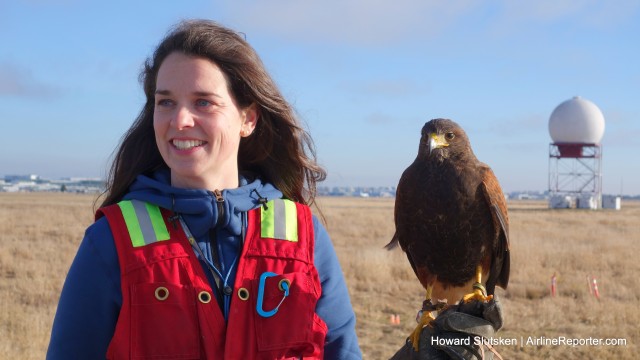
Emily Fleming, Raptor Biologist with Pacific Northwest Raptors, and Goliath, the Harris’ Hawk, in front of YVR’s radar “golf ball”
Airplanes and birds don’t play well together.
Just ask Captain Sully and First Officer Jeff, whose encounter with a flock of Canada Geese turned their A320 into a glider. Or talk to the crews of the approximately 150 planes per year at Vancouver International Airport that report bird strikes. Flight safety can be seriously compromised, repair costs for the airlines are huge, passengers are often inconvenienced, and for the birds, well, it’s fatal.
Vancouver International Airport (YVR) is located on the shores of the Strait of Georgia, on a large island in the Fraser River Delta. And just like the passengers who connect at YVR, the millions of birds that annually use the migratory Pacific Flyway like to stop in the Vancouver area to get something to eat and have a rest. Boundary Bay, south of YVR and the location of the general aviation Boundary Bay Airport (ZBB), is an internationally-recognized Important Bird Area. Even the main Vancouver air navigation aid, the YVR VOR, is on the same island as the renowned Reifel Migratory Bird Sanctuary.









